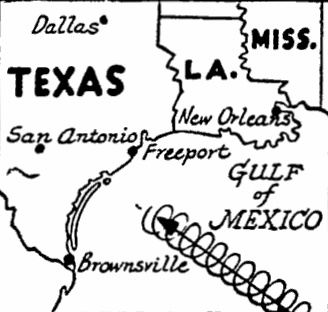The Pittsburgh Press (September 23, 1941)
Hurricane flags fly –
THREE STATES HAMMERED BY STORM IN GULF
…
Outer fringe of blow hits Freeport; high tide flood cities
…

Houston, Tex., Sept. 23 (UP) –
A hurricane roared northwestward through the Gulf of Mexico today and the gales and great tides that preceded it gave towns along the central Texas coast warning of the dangers it held for them. Effects of the storm were already felt along the Louisiana coast and as far east as Biloxi, Miss.
Thousands of persons had locked their homes and fled inland.
The outer fringes of the violent Gulf twister had already reached Freeport this afternoon. There it was tearing up trees and had sunk two fishing boats in the harbor. Mayor William Allan reported that this was the only damage so far. He was one of the few men remaining in town. Most of the 6,000 residents had fled Freeport earlier after the government warned that the storm center would strike close to the community.
River backed up
The focal point of the storm appeared to be between Freeport and Port O’Connor, 75 miles southwest on Matagorda Bay.
Freeport is protected by levees, but high tides had backed sea water into the Brazos River and forced it out of its banks. The barometer was falling rapidly.
At Galveston, the wind was decreasing and the tide was falling, an indication that the center of the storm, still 100 miles at sea, had passed westward, and this was borne out by the higher tides and the blustery weather that swept into Port O’Connor.
The Weather Bureau said the hurricane was moving forward about six miles an hour with winds of full hurricane force near the center.
If the storm continues at its present movement, the advisory added, it will reach the coastline near Port O’Connor tonight, attended by winds up to 90 miles an hour. Dangerous gales northeast to Port Arthur, Tex., and southwest to Corpus Christi will result.
Thousands flee
Galveston felt the storm last night and thousands of its 60,000 residents and hundreds of tourists, mindful of the storm in 1900 that took 6,000 lives, fled over the causeway and north to Houston.
Port Arthur, protected by a 10-foot levee, reported winds of 50 miles an hour, a tide 5.5 feet above normal and floodwaters in lower sections of the city. Coastal highways outside town were blocked by tidewaters.
Highways were also inundated between New Orleans and Biloxi.
Corpus Christi, the site of the Navy’s new Annapolis of the air, also reported high winds and heavy tides sweeping the lowlands.
At Freeport, the Dow Chemical Company’s new $25-million plant to produce magnesium, a vital defense element, was left to the hurricane’s mercy.
Among the thousands of lowland residents who poured into this and other inland cities offering haven were 5,000 Army Air Forces soldiers from Ellington Field 18 miles south of here. They were bivouacked at the Municipal Coliseum.
The only other large encampment in the threatened area is Camp Hulen at Palacios, behind Matagorda Bay, near Port O’Connor. Officers would not say how many soldiers remained there. It was built to accommodate 12,500 trainees but most of its personnel is in Louisiana for the war games.